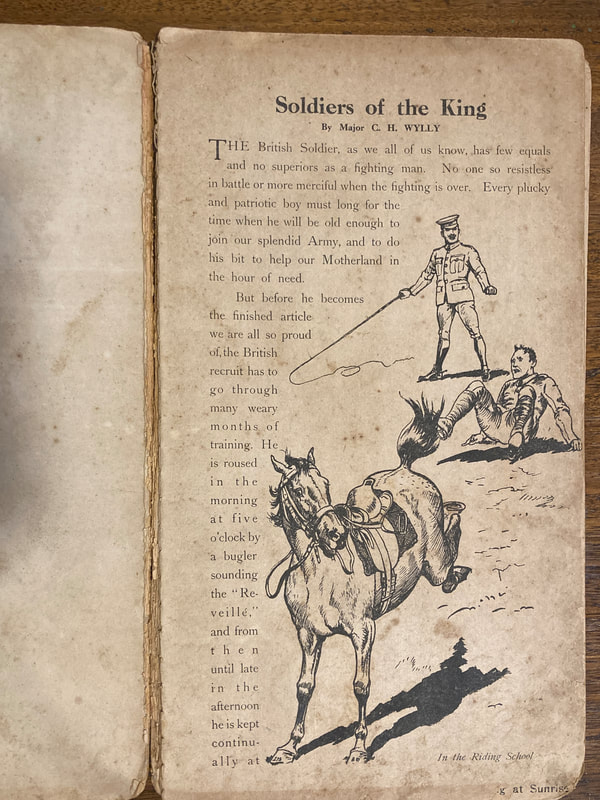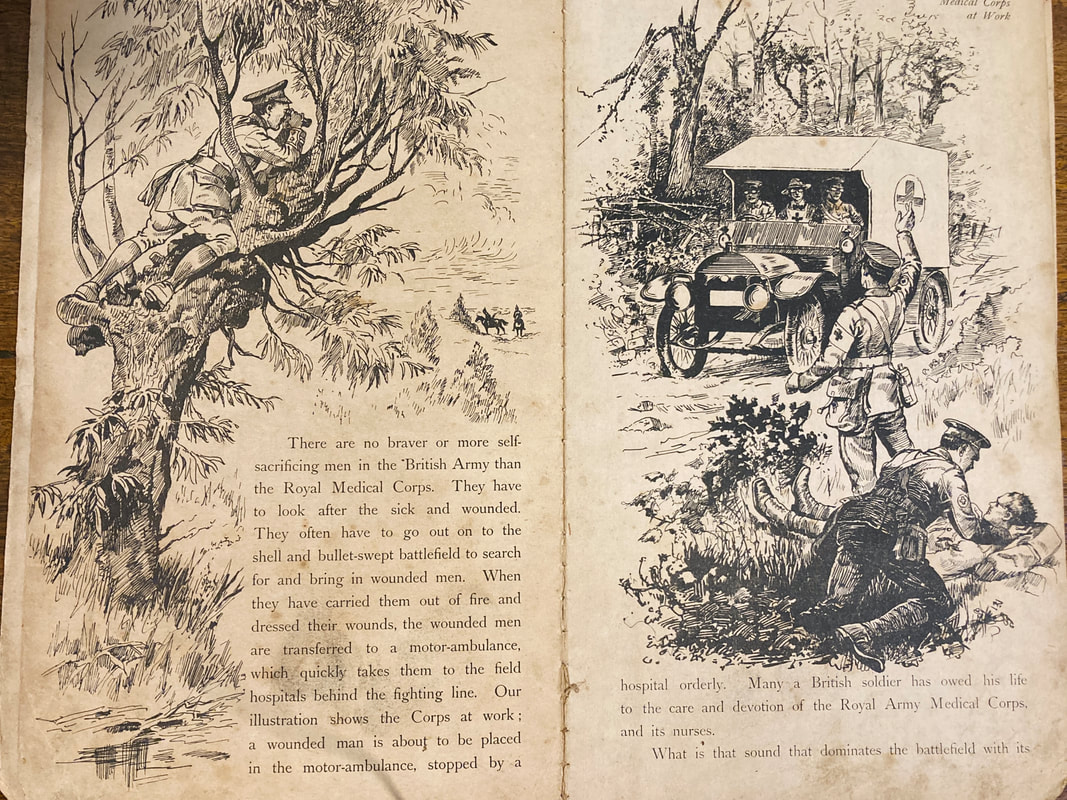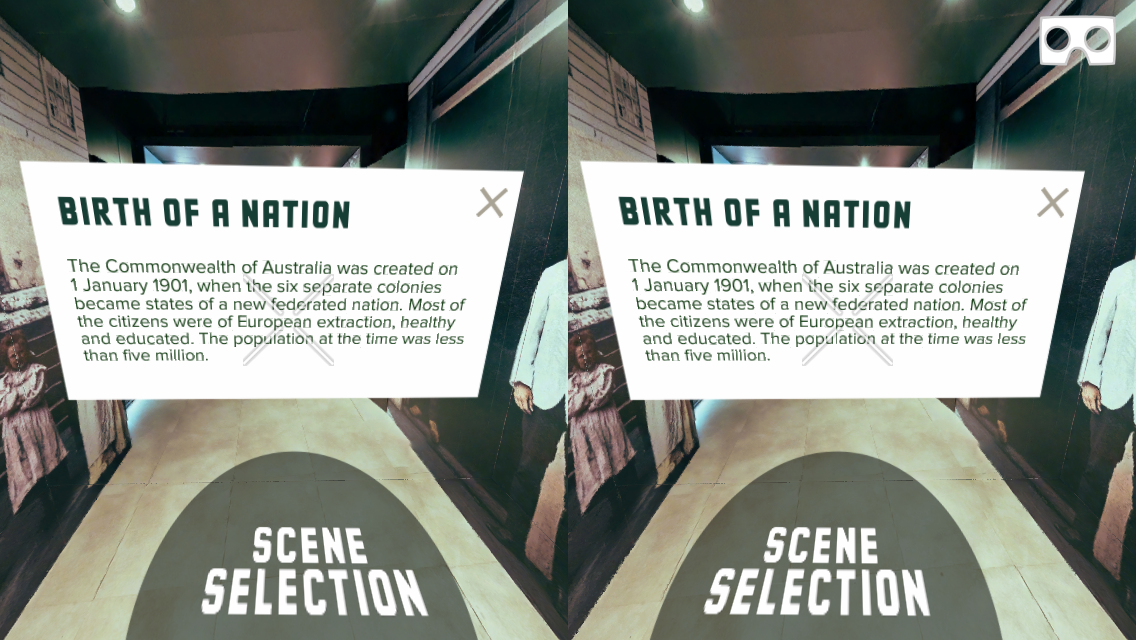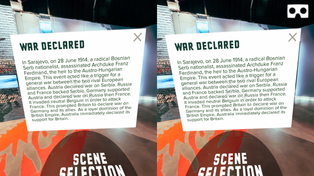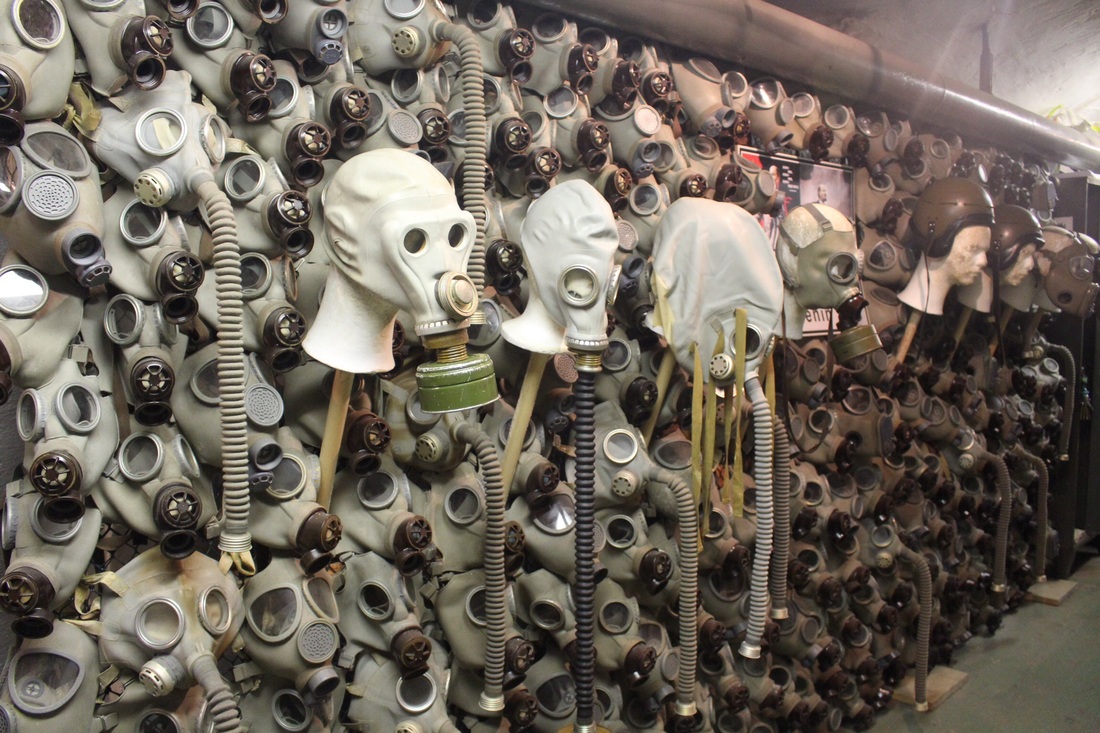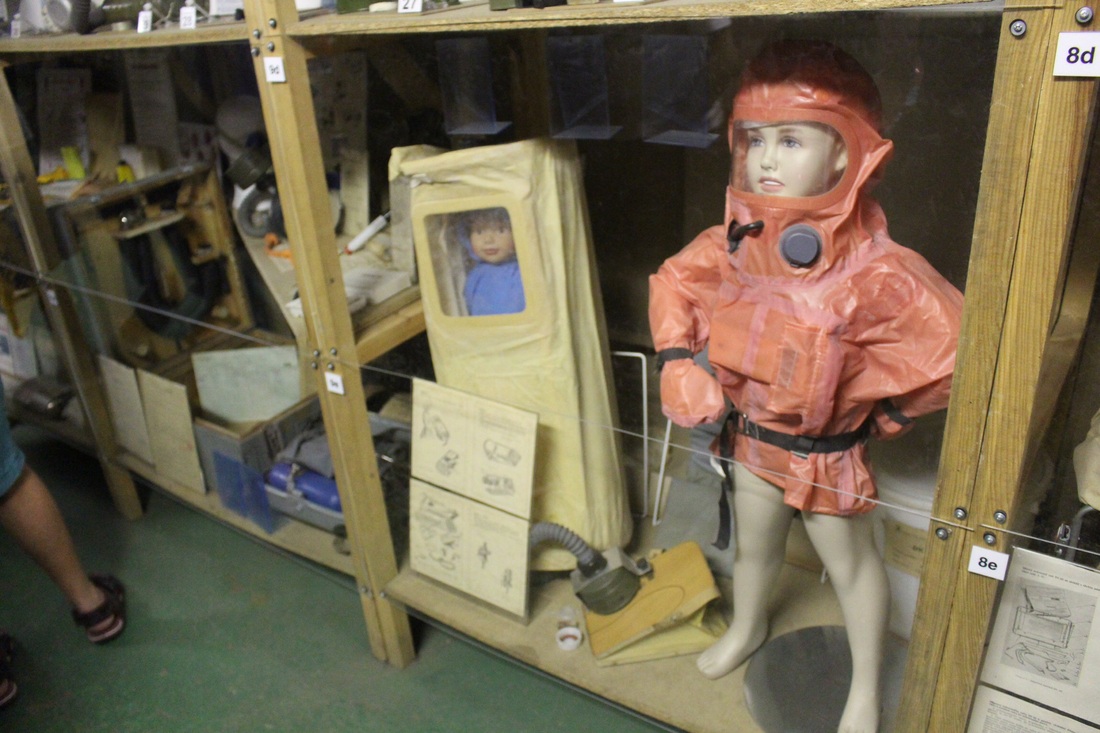|
Sometimes a gem just falls into your lap. While cleaning out my parents house to move we came across this picture book in amongst some family memorabilia. My grandfather was born in the early 1920s, so we think it must have belonged to one of his older brothers or sisters. This book is part of the Father Tuck's "Patriotic Series" and appears to have been published in 1917. It provides descriptions of various roles within the British Army with beautiful illustrations accompanying it. Activities:
- Outline the evidence there is to indicate a rough date of publication. - Identify the demographic group ( this might be age, gender, ethnicity, etc) this book is targeted at. - What do you think of the illustrations? Describe the purpose of the illustrations. - This picture book could have a number of different purposes. Discuss the purposes of the picture book and provide examples/phrases in the book that provide evidence of these purposes. - Identify any words, phrases or concepts that are out-dated or no longer in use.
0 Comments
As a family we are lucky that my Pop audio recorded some of his life story including his experiences in PNG during WWII. The video below is an excerpt of these recordings with some photographs taken at the time of him, some of his fellow soldiers and family members. In the lead up to ANZAC Day this year, a number of organisations have shared some great resources. The Poppy Field Project has released an interactive infographic which shows war fatalities in the 20th century using different sized poppies. Information can be interrogated by continent, by sorting by size of conflict, and by displaying particular time periods. Click to view the Poppy Field Interactive SBS OnDemand is airing "From paradise to Hell": First Nations ANZACs and the fight to honour them. You can read more about it here:
'From paradise to hell': First Nations ANZACs and the fight to honour them View the show on SBS OnDemand Some other places to look for some great resources: Teachstarter have a great collection of Thoughtful ANZAC Day activities and resources. The ANZAC Portal from the Department of Veterans' Affairs. Resources from the Australian War Memorial The NSW Department of Education ANZAC resources
On 17th September he was admitted to the 5th Field Ambulance, Rest Gully, Gallipoli and was then transferred to the 1st Australian Casualty Clearing Station. He was suffering from Otitis Media, a middle ear infection, but it forced him to be hospitalised for a considerable time – 26 days, and it developed into an ear abscess. He embarked at Dardenelles on the HS Mahena, and disembarked at Malta where he was admitted to Hamrun Military Hospital on 18th October 1915. Below is a transcript of correspondence between Charles' father Samuel and military personnel. It mostly relates to his injuries and hospitalisations (gassing, eye injury, etc), but also the circumstances around his medal towards the end. It gives a good picture of the frustrations faced by families in trying to get information about their loved ones. ____________________ Samuel Anderson Boambee, Via Coffs Harbour (NSW) Regret reported son Private C.E.Anderson disembarked for Malta Hospital ship Maheno 23rd September slightly sick. Will promptly advise if anything further received. Base Records 9/10/15 ____________________ Mr. S. Anderson Boambee, via Coffs Harbour Australian Imperial Force Base Records Office A.I.E.F. Victoria Barracks, Melbourne 2nd December 1915 Dear Sir, The following is an extract from a Nominal Roll of sick and wounded received by post, dated 28/9/15 who landed at Malta 23rd September from hospital ship “Maheno”, No. 2327 Private C. E. Anderson, 1st Battalion, suffering from abscess ear. Any further reports received will be promptly communicated to you. Yours faithfully, J.M. Lean Captain Officer i/c Base Records. ____________________ Mr. S. Anderson Boambee, via Coffs Harbour Australian Imperial Force Base Records Office A.I.E.F. Victoria Barracks, Melbourne 6th January 1916 Dear Sir, The following is an extract from a Nominal Roll of Officers, Non-Commissioned Officers and Men, received by post, dated 18/11/15 who embarked at Malta for Mudros on H.T. “Hurno” on 15/11/15, No. 2327 Private C.E. Anderson, 1st Battalion, fit for active service. Any further reports received will be promptly communicated to you. Yours faithfully, J.M. Lean Captain Officer i/c Base Records. ____________________ Boambee 30th October 1917 Dear Sir Please can you inform me why I am not notified when my son No 2327, Gunner, C. E. Anderson, 13th Battalian, Australian Field Artillery, has been wounded. This soldier was ill in hospital for three months last Christmas and in June had a poisoned hand, in July he was buried by a shell and had his eye injured, in August was admitted to hospital, wounded and I have not been officially informed on any occasions. The only information I have received is from himself and other boys who are on the other side (at the front). I am yours faithfully, Samuel Anderson ____________________ Mr. S. Anderson Boambee, via Coffs Harbour 8th November, 1917 Dear Sir, In reply to your letter of the 30th, I have to advise that no report has been received here to that effect that your son No. 2327, Gunner C.E. Anderson, 13th Field Artillery Brigade, has been recently wounded, but, if you can forward to this office authentic documentary evidence, such as a letter containing this information, enquiries will, if warranted, be instituted and the result communicated to you. Yours faithfully, Major. Officer i/c Base Records. ____________________ 8th March 1918 Honour or Reward: D.C.M. Recommended by: A.J.Bessel-Browne; C.R.A. 5th Aust. Div. Action for which commended: This Gunner has served with his Battery continuously during the period 22nd September 1917 to 25th February 1918. While it was in action at Westhork, East of Ypress, he was gassed on two occasions but declined to leave the position. He is an excellent layer, and his presence was very valuable on account of the heavy casualties. On the afternoon of the 15th October 1917 a neighbouring battery position was shelled by an 8th Howitzer Battery, direct hits smashing a pill-box, and severely wounding three of the occupants. Although this fire continued, Gunner Anderson, assisted by another gunner, without hesitation, went to this pill-box and succeeded in getting the wounded men out and carrying them to a place of safety. In doing this, he showed a total disregard of personal danger and had many narrow escapes from bursting shells. His conduct during the whole time his Battery was in action has been excellent, and by his courage and devotion to duty he has set a splendid example, which is deserving of special recognition. Signed J.T. Hoebs Major-General Commanding 5th Australian Division ____________________ 16th July 1918 Dear Sir, I now beg to advise you that Private C.E.Anderson has been reported gassed (classed as wounded). His postal address will be No. 2327 Gunner C.E. Anderson “D.C.M.” 13th Field Artillery Brigade, Australian Imperial Force, Abroad. In the absence of further reports it is to be assumed that satisfactory progress is being maintained, but anything later received will be promptly transmitted it being clearly understood that if no further advice is forwarded this department has no more information to supply. Yours faithfully, JMLean Major, Officer in Charge, Base Records. ____________________ Bonville 25th July 1918 Sir I have received information through the Base Record Office stating the No 2327, Gunner C.E. Anderson D.C.M. has been reported gassed. Has any information come through previously with regard to him winning this medal. If so we have never received it. His address is now given to me as 13th Field Artillery Brigade whereas before it was 113th Howitzer Battery. Please inform me if this is a misprint. And kindly oblige, please note change of address S Anderson Bonville North Coast New South Wales ____________________ Boambee Via Coffs Harbour Samuel Anderson Now reported Gunner Charles Anderson admitted Fourteenth Stationary Hospital. Boulogne France sixth July. Gassed. Dangerous. Further Progress report expected. Base Records 25/7/1918 ____________________ Mr Samuel Anderson Boambee Via Coffs Harbour Now reported Gunner Charles Anderson pronounced out of danger. Base Records 31/7/18 ____________________ 1st August 1918 Dear Sir, I now beg to advise you that Gunner C.E.Anderson”D.C.M.” has been reported transferred to Endell Street Military Hospital, London, England, on 17/7/18 and is now removed from seriously ill list. His postal address will be No. 2327 Gunner C.E. Anderson “D.C.M.” 13th Field Artillery Brigade, (late 1st Battalion) Australian Imperial Force, Abroad. In the absence of further reports it is to be assumed that satisfactory progress is being maintained, but anything later received will be promptly transmitted it being clearly understood that if no further advice is forwarded this department has no more information to supply. Yours faithfully, JMLean Major, Officer in Charge, Base Records. ____________________ 7th August 1918 Mr S. Anderson Bonville, North Coast, NSW Dear Sir, With reference to your communication of 25th July, I have to inform you that beyond the fact that the letters “D.C.M.” were quoted after your son’s name in the cable reporting his casualty, nothing further is known of the award. Notification will, no doubt, come to hand at a later date by mail, when you will be officially advised. I would point out that the 113th Howitzer Battery is a portion of the 13th Field Artillery Brigade, and if you so desire you can address the soldiers’ mail matter as under:- No. 2327 Gunner C.E. Anderson 113th Howitzer Field Artillery Brigade (late 1st Battalion) Australian Imperial Force, Abroad Yours faithfully, Major Officer i/c/ Base Record P.S. Your change of address is noted. ____________________ 9th August 1918 Dear Sir, I now beg to advise you that Gunner C.E.Anderson “D.C.M.” has been reported convalescent. His postal address will be No. 2327 Gunner C.E. Anderson “D.C.M.” 13th Field Artillery Brigade, Australian Imperial Force, Abroad. In the absence of further reports it is to be assumed that satisfactory progress is being maintained, but anything later received will be promptly transmitted it being clearly understood that if no further advice is forwarded this department has no more information to supply. Yours faithfully, JMLean Major, Officer in Charge, Base Records. ____________________ Base Records Office Victoria Barracks Melbourne, 15th November 1918 Dear Sir I have much pleasure in forwarding hereunder copy of extract from Second Supplement No. 30716 to the “London Gazette” dated 3rd June, 1918, relating to the conspicuous services rendered by the undermentioned member of the Australian Imperial Force. AWARDED THE DISTINGUISHED CONDUCT MEDAL No. 2327 Gunner C. E. Anderson The above has been promulgated in “Commonwealth of Australia Gazette” No.173 dated 7th November 1918. Yours faithfully Capt. For Major, Officer i/c/ Base Records. Distinguished Conduct Medal 'For conspicuous gallantry and devotion to duty. He was severely gassed on two occasions, but declined to leave his post, and on another occasion he went to the rescue of some wounded in a 'pill box" that had been smashed by an 8 in. shell and was still under heavy fire. In spite of great difficulty and danger, with the aid of another gunner he extricated the wounded and carried them to a place of safety. He has always set an example of great courage and devotion to duty that is worthy of the highest praise.' Source: 'Commonwealth Gazette' No. 31 Date: 4 March 1919 ____________________ Samuel Anderson Bonville (NSW) No recent report Regarding son. Assumed with unit. Base Records 22/3/19 ____________________ Charles was awarded the Distinguished Conduct Medal (DCM). He was presented with the award by King George V at Buckingham Palace. He married an English nurse named Edith Mills who had cared for him while he was in hospital after being gassed.
23rd July 1919 Charles returned to Australia, and received the War Pension, but went on to have great success in dairy farming and breeding cattle. The Spirit of Anzac is a touring exhibition featuring genuine artefacts and stories. To promote the tour the Australian War Memorial and the Australian Government have sent out packages to schools of about 10 Google Cardboard head sets in boxes. You can download the Spirit of Anzac 360 Explorer App from the App Store or Google Play.
The actual headset is already made when it arrives and is packaged within a cover to protect the set. It is quite robust (a little more sturdy than the Google Cardboard sets I have purchased from Ebay before and discusses in previous posts). The lenses are quite large, which will enhance the viewer experience, and some additional velcro and padding should also add to the experience. The App provides an interactive tour of the displays at the Spirit of Anzac exhibition. Students can focus on a particular image and information pops up to explain the display. This isn't as immersive as some other Google Cardboard apps that I have reviewed, but given that it is being sent to schools for free and that the app is free it would be a useful and interesting way to engage students with the displays prior to a visit. The exhibition is showing at:
Explore The Spirit of Anzac - What to Expect Access the Spirit of Anzac Google Cardboard User Guide Some other options of Google Cardboard/Virtual Reality apps that you might like to look at are: War of Words VR This VR experience uses the Seigfried Sassoon poem "The Kiss" as the basis of the experience. It is an animated experience created by BBC Arts. It promotes the feature-length documentary War of Words - Soldier-poets of the Somme. Trench Experience Trench Experience enables the user to experience an authentic trench from world War I. This is like a virtual museum. Diggers Trench VR This VR experience is only available with Oculus Rift - not Google Cardboard. However, I imagine that as Google Cardboard begins to be used more that this will be the type of experiences that we can expect more of. This is more story based. As a new recruit you experience life in the tranches and are able to influence some of the events that unfold in the story. For Stage 4 History, you may like to refer to a resource I created a few years ago (as mentioned in a previous post). Click here to examine the Syllabus Bite on Ancient India. As you progress through the topic you might like to use the glossary file below to help students develop knowledge of key terms. There is also a glossary quiz file, but you may like to break this up into a couple of smaller quizzes depending on the ability of your students.
Students must explore the beliefs, values and practices of ancient India. The handout below introduces a few key terms, provides a brief summary of beliefs, values and practices and outlines a short group work task.
The activity below allows students to examine the physical features of ancient India including mountain ranges, plains, deserts, wetlands, rivers and highlands. Students are required to complete a mapping activitiy to show the spatial distribution of these features.
A person of significance must be examined. Below is a short introduction to Ashoka including a few relevant key terms and a short cloze passage. For more detail on Ashoka examine my previous post Teaching Ashoka.
Using picture books to integrate Geography and History into Stage 1 – Home by Jeannie Baker8/22/2016
http://www.jeanniebaker.com/book/home/ Introductory activities: Front cover: Does this place look like your neighbourhood or community? Do any of these houses look like your house? Do any of these backyards look like your backyard? Does this look like a nice place to live? Why or why not? The story begins with a pregnant woman and her husband moving into a home, and traces the steps of Tracy, their daughter's, life. The window frame and the wall around it provide clues to show that time is passing - a card celebrating the birth of a new baby, a mug with "I am 4" on it, a note about her 10th birthday, and on it goes. The documenting of time passing provides a opportunity to begin to explore the historical concept of change and continuity and develop skills in sequencing events. This would need to be accompanied with explicit teaching of days of the week and months, and also holidays, events celebrated by students and their families. Activity: Students are provided with images representing Tracy's age and are asked to cut them out and glue them in the correct sequence. Students bring in photos of their childhood with the ages written on them and sequence them to create a timeline. The teacher uses photos of the class or school throughout the year to create a timeline as a wall display. See this pinterest post: https://au.pinterest.com/pin/205547170466044607/ The geographical concept of place is explored in terms of their unique characteristics, the value we place on places, and human influences. We see the way Tracy and her family interact and influence their own backyard, and we get an idea about how they value their place by the activities and experiences they have there. We see how the community begins to value place as the neighbourhood changes into a thriving place for people to relax, interact and work. Activity: Students identify their favourite places around the school and at home. Why do they like these places the most? How do different places make you feel? Are some places safe places? The geographical concept of change is an obvious theme throughout this book. The backyard develops from an empty, barren space into a shady, green oasis. We see the neighbourhood develop from a run down, graffitied area into a green, friendly community. The smash repairs develop into a local park, the demolition of a large building opens up the view of a lake and parkland, old buildings are renovated and new buildings are constructed. We have glimpses of the development of the city, but much of this is hidden by the greening, leafy community. Activity: Students take photographs of a change occurring in their school or local environment (excursion) and label them. This could be repeated several times so that there is a visual record of the change. Student examine historical photos of their suburb and compare them with contemporary photos. A study of the illustrations provides an opportunity to introduce the geographical concept of scale. There is enough visual interest and complexity to simply concentrate on the changes that occur within the family backyard. This could then be extended to looking at what can be seen on the street corner opposite and the main street. This enables discussion about a community, suburb or local scale. In the background of the illustration you can see the city skyline, this could be used to introduce the scale of the town or large city. Activity: Students are given a template with different sized circles. They use the template to draw images of their house, their street, their community, their city, their country and the world (starting from smallest to biggest). This could then be repeated with images of themselves, their immediate family and their extended family. See this pinterest post: https://au.pinterest.com/pin/451274825131466444/ While the story only examines a timespan of approximately 25 years, it does provide a chance to begin to explore the historical concept of changes and continuities in family life and the local community over time. The story comes full circle when the main character gets married and has her own child. We can begin to introduce the historical concept of empathetic understanding by asking why the yard of the family home looked so different when they first moved in to how it looked at the end of the story. Why did Tracy's parents live differently at that time in history to the way they live now? Activity: Students bring in artefacts, or treasured family objects (perhaps a photograph if it is really treasured) and recount family stories. They ask other students questions about their objects. While the geographical concept of sustainability is not expected to be addressed in Stage 1, this story has a clear message encouraging communities to bring back native plants and animals, and to better understand and care for places.
Outcomes:
Communicates an understanding of change and continuity in family life using appropriate historical terms. Identifies and describes significant people, events, places and sites in the local community over time. Inquiry questions: How has family life changed or remained the same over time? How can we show that the present is different from or similar to the past? How do we describe the sequence of time? It would also be quite easy to make links to the English, Maths and Art syllabuses. Guest blogger: Bruce BarclayThe recently released stage six draft modern history syllabus fails to clearly articulate a vision for the study of modern history in a globalised world. In its previous incarnation, the stage six syllabus at least paid lip service to areas of modern history which were not European in nature, i.e. India as one option. This final draft does not reflect the four options which were tabled to teachers who took the time to provide feedback to BOSTES previously. Teachers of this subject have been ignored with the release of the final draft.
The National Study and Peace and Conflict topic areas have been left relatively unscathed. However the inclusion of Iran into the national study topic area replaces India which is a lost opportunity. Similarly, the Peace and Conflict topic retains the main options, with the inclusion of Conflict in the Gulf 1991-2011, which replaces the UN as Peacekeeper. Essentially these two areas of study have escaped political influence. One of the real, if not the most problematic areas, is the core topic. Instead of utilising one of the options tabled at the consultation process, BOSTES has obviously bowed to political pressure and ignored the recommendations of the majority of teachers. World War One was a topic which although staid, at least had the advantage of being politically neutral and allowed teachers to engage in different national studies with no disadvantage to its students. For example a teacher of the USSR topic can build on students’ knowledge of the World War One topic. However as it stands, the core topic is Nazi Germany 1933-39 and teachers have to cover 9 detailed dot points taking up 60% of course time. To further compound the problem, teachers then need to teach another dictator, e.g. Pol Pot for 30% of the course. This begs the question: why is Nazi Germany deemed the most important topic for the core? Compounding the obvious bias, is that instead of removing Nazi Germany from the National Study it keeps Nazi Germany, but focuses on 1914-33. Clearly any teacher with half a brain will teach the German National Study first, then the Core/Nazi topic and if you haven’t got your fix of Nazi German history, you could finish with the European Conflict option for the Peace and Conflict topic. Already roughly 70% of the state teaches the Nazi option for the National Study so BOSTES wants the rest of the state to follow suit. As one person at the BOSTES consultation meeting at Hurstville remarked “That’s the end of the Soviet Union in every sense”. The USSR and for that matter the other options have been "relegated to the dustbin of history," to quote Goebbels, I mean Trotsky. It’s already working! Unlike the Ancient History course, BOSTES have removed the Personality topic from Modern History and replaced it with Change in The Modern World. I actually thought there has been a lot of change in the modern world in the twentieth century - that is why students love studying Modern History. BOSTES wants teachers to not only teach a personality, e.g. Gorbachev but link it to a time frame of nearly 70 years - The Changing World Order 1945-2011. This option has 19 dot points to cover, plus an evaluation of Gorbachev during the Cold War period. Furthermore, as a hat tip to the old UN as Peacekeeper topic, teachers have to assess the role and impact of the UN as international peacekeeper in relation to one trouble spot in the world, e.g. Somalia. Evidently the old inconsistencies of comparability between the ancient and modern course remain but are amplified, further alienating modern history teachers. If I was a student and had equal interest in modern and ancient history I would choose ancient for ease of content and variety. I hope that someone more technically adept than myself will be able to create a parody of the modern syllabus using snippets from The Downfall movie on youtube. I won’t even start on the exam specifications. Following the responses from similar, previous posts for Geography and Legal Studies, I have created a revision schedule for students in the lead up to HSC Trials for Ancient History. You will obviously need to modify it based on your options, but you can at least use it as a scaffold. Have a look at the previous posts regarding the study planner based on other subjects for more details.
On the 100th anniversary of the assassination of Archduke Franz Ferdinand, the event that sparked World War I, a new video game Valiant Hearts: The Great War was released. The game is based on World War I and players can play as one of four characters: Karl, a deported German separated from his family; Anna, a Belgian student and battlefield nurse; Emile, who has been drafted into the French army and sent on a suicidal mission; and Freddie, an American motivated by personal vengeance. The game has been designed in the style of a graphic novel, and the design was intended to emotionally engage players in the personal stories of the characters. It uses real letters throughout as narrative for the game. It teaches players about facts of World War I and contains a detailed encyclopaedia that players can access throughout gameplay. While the game involves the player in the action of WWI, it does not involve the usual shoot and kill action, but rather involves more puzzle solving and storytelling. For a closer look you can view the walkthrough from Giant Bomb below. There have also been some other great links to resources circulated lately. You might like to check out: Every day of WWI in a 6 minute time lapse film 37 days: Countdown to World War I European Film Gateway 1914 Revealed: The first Australian to die in World War I Interactive WWI timeline History Channel - World War I videos PBS - The Great War Lesson Plans You might also like to look at this very comprehensive list of resources: World War One: Some Centennial Links, Readings, Contexts Cold War history is predicated upon the difference between East and West. To that end the history focuses on Moscow and Washington. Rarely do historians focus upon the satellite countries of the Eastern Bloc and to a lesser extent the Western bloc. Czechoslovakia, now known as the Czech Republic, offers an interesting insight into the Cold War. In 1968, the Prague Spring occurred where the leaders of Czechoslovakia desired to have a say in the manner in which communism was to govern their country. Leonid Brezhnev the Premiere of the USSR brutally crushed the Prague Spring by invading the country with 500,000 troops and 4,500 tanks to crush any questioning of the manner in which Eastern Bloc countries were governed. This was referred to as the Brezhnev Doctrine by which the USSr was able to intervene in Eastern Bloc countries without ramifications from the USA and NATO.
Train stations and tunnels in Prague double as nuclear shelters. The stations and tunnels can be closed off with the use of lead doors to protect the population. The cavities for these blast doors are clearly visible to the trained eye at the base of the escalators at the entrance to each platform. Near the Flora railway station is a large bunker which now houses the Nuclear Bunker Museum. The entrance to the bunker resembles a graffitied, walled basketball court. To the general public it is not immediately obvious or accessible. To gain access the bunker needs to be unlocked by a tour guide. The shelter was designed to protect approx 2,500 people. The blast door to the shelter is nearly 1 metre thick and leads to a double helix staircase - one side for entry and one side for exiting. The staircases go down 16 metres to the bunker proper.
Related article:
Soviet ghosts: An empire in decay |
Categories
All
Archives
May 2024
|
||||||||||||||||||||||||||||||||||||||||||||||||||

